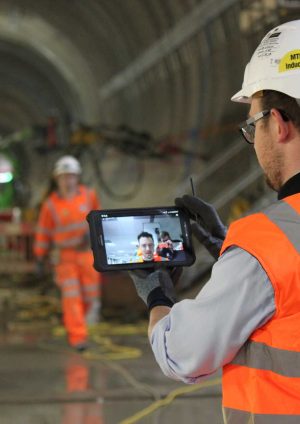Introduction and Industry Context
Crossrail now has approximately 900 mobile devices made up of iPhones and iPads. The team managing them initially recorded details of the devices and owners on spreadsheets. This worked well whilst the project was small and in start up mode but once it grew and matured into a more sizable organisation and there was an increase in the number of joiners and leavers, it became more difficult to ensure accurate records were being maintained. This also caused difficulties when a device was lost or stolen and the device information needed to be found and reported to the network provider to block the service and disable the device.
Story
An organisation like Crossrail has a large mobile work force and although many have their own phones, some need a corporate supplied device to ensure they can do their job.
Records of these devices were original maintained manually but as the company grew, so did the mobile phone requirement and a growing management overhead. To reduce the management overhead and improve the quality of mobile device records greater automation and a better approach was needed to ensure Crossrail had a good grasp of the mobile estate and the usage patterns.
In 2013 the estate numbers and usage were reviewed and business plans consulted to understand the expected demand for the Crossrail project for the future years to take us to the end of the project in 2018. Other organisations of a similar type and technical analyst groups e.g. Gartner were consulted to get up to date information on what was happening in the market for mobile device management. With the information gathered, the approach taken was to look at the market for suitable mobile device management solutions and then implement a Mobile Device Management (MDM) solution from a viable supplier.
The ability to allow users own devices to be connected to the network was investigated but there was little interest from the Crossrail user base.
To simplify the implementation, a cloud hosting option was selected which allowed for a quick setup and device enrolment. Once the existing estate was enrolled, all changes were managed by the MDM solution ensuring that there was a record of every device and its owner. In the situation when a device was lost or stolen it could be wiped and disabled within minutes of notification to prevent any use or access to any locally saved documents and data.
Crossrail also had a requirement to build mobile applications and with the addition of a Mobile Access Gateway server installed in the Crossrail domain, Crossrail was able to deploy applications and provide secure access to internal data. Mobile Application Management (MAM) allows applications and updates to be pushed out to devices or allow the device owner to pull on demand. A recommended set of applications can be identified to enable a new device to be set up quickly.
Crossrail also used the MDM capability to block iOS updates when these were known to be a problem. This allowed Crossrail to selectively update individual devices to test and once satisfied the release was acceptable, remove the block for the rest. This ensured there was a minimal impact to the users of these devices.
Lessons Learned
A manual approach to managing mobile devices works when the number of devices is small (less than 100) and there is a low level of change but this soon becomes unmanageable.
The cost benefit in having central management of mobile devices is easy to calculate once lost and stolen process is considered.
Bring Your Own Device (BYOD) is also supported by the technology and has the benefit of securing company information on a personal device. Surprisingly, not many users were interested in having this capability added to their own devices due to concerns of being tracked by the solution.
Technology is always evolving. Keeping engaged with the supplier ensures you get access to new features earlier.
Some applications (Apps) are better than others so a recommended list of Apps should be compiled to share with the device users
Recommendations for Future Projects
- Check the market for suppliers of MDM solutions and pick a solution which has a reasonably high take up and the features that are really required
- Implement MDM at an early phase of project life / as soon as practical
- If mobile application development and deployment is required, ensure the MDM supplier can support this function
- MDM vendors will often offer features which are unlikely to be required. Make sure requirements are fully understood before selecting a short list of potentials
- Suppliers promise a lot but the time to deliver is never guaranteed. Ensure the features needed are already mature in the product suite
- Create a user policy on mobile device use and include approach to buying Apps for users

